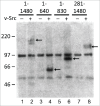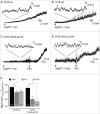Potential sites of CFTR activation by tyrosine kinases
- PMID: 26645934
- PMCID: PMC4954566
- DOI: 10.1080/19336950.2015.1126010
Potential sites of CFTR activation by tyrosine kinases
Erratum in
- doi: 10.1096/fj.15-273151
Abstract
The CFTR chloride channel is tightly regulated by phosphorylation at multiple serine residues. Recently it has been proposed that its activity is also regulated by tyrosine kinases, however the tyrosine phosphorylation sites remain to be identified. In this study we examined 2 candidate tyrosine residues near the boundary between the first nucleotide binding domain and the R domain, a region which is important for channel function but devoid of PKA consensus sequences. Mutating tyrosines at positions 625 and 627 dramatically reduced responses to Src or Pyk2 without altering the activation by PKA, suggesting they may contribute to CFTR regulation.
Keywords: CFTR regulation; Pyk2; Src; cystic fibrosis; phosphotyrosine.
Figures


References
-
- Aleksandrov L, Aleksandrov AA, Chang XB, Riordan JR. The first nucleotide binding domain of cystic fibrosis transmembrane conductance regulator is a site of stable nucleotide interaction, whereas the second is a site of rapid turnover. J Biol Chem 2002; 277:15419-25; PMID:11861646; http://dx.doi.org/10.1074/jbc.M111713200 - DOI - PubMed
-
- Basso C, Vergani P, Nairn AC, Gadsby DC. Prolonged nonhydrolytic interaction of nucleotide with CFTR's NH2-terminal nucleotide binding domain and its role in channel gating. J Gen Physiol 2003; 122:333-48; PMID:12939393; http://dx.doi.org/10.1085/jgp.200308798 - DOI - PMC - PubMed
-
- Wilkinson DJ, Strong T V, Mansoura MK, Wood DL, Smith SS, Collins FS, Dawson DC. CFTR activation: additive effects of stimulatory and inhibitory phosphorylation sites in the R domain. Am J Physiol 1997; 273:L127-33; PMID:9252549 - PubMed
-
- Gadsby DC, Nairn AC. Control of CFTR channel gating by phosphorylation and nucleotide hydrolysis. Physiol Rev 1999; 79:S77-107; PMID:9922377 - PubMed
-
- Fischer H, Machen TE. The tyrosine kinase p60c-src regulates the fast gate of the cystic fibrosis transmembrane conductance regulator chloride channel. Biophys J 1996; 71:3073-82; PMID:8968578; http://dx.doi.org/10.1016/S0006-3495(96)79501-2 - DOI - PMC - PubMed
Publication types
MeSH terms
Substances
Grants and funding
LinkOut - more resources
Full Text Sources
Other Literature Sources
Miscellaneous
